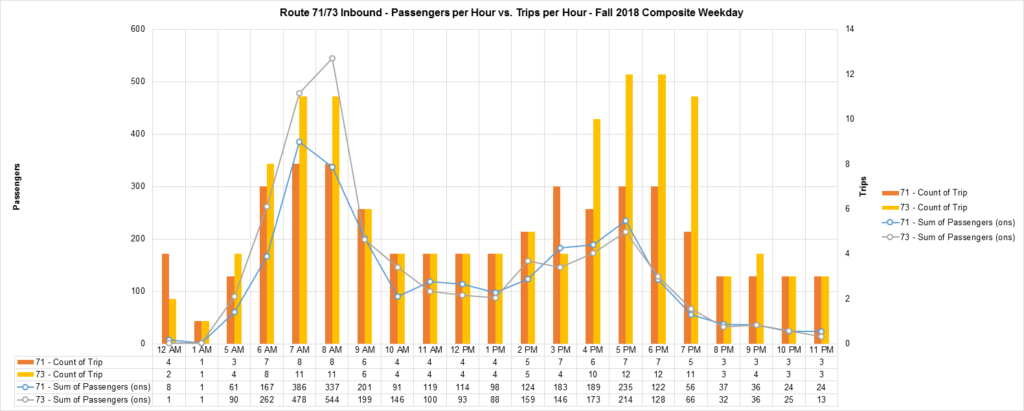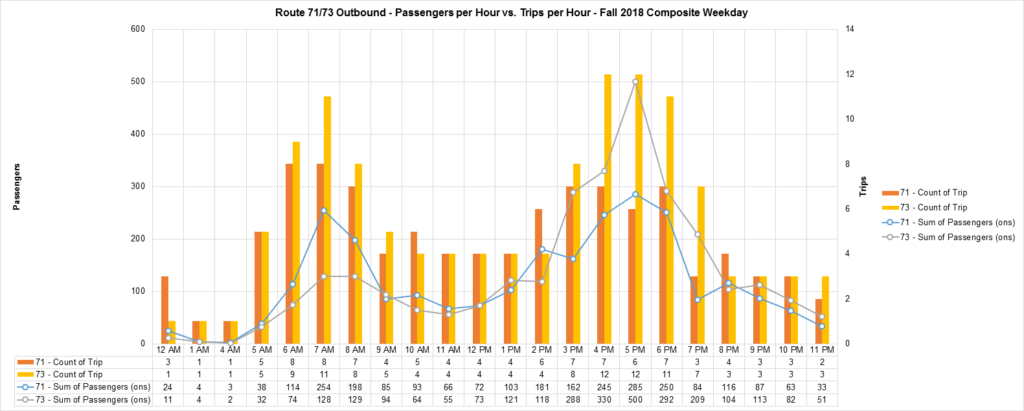I frequently get asked about the relative allocation of buses on the 71/Watertown route and the 73/Waverley route. The buses pick up passengers at adjacent births and often riders on one line suspect that riders on the other are getting better service. In fact, there are more buses on the Waverley line, as a result of higher peak service demand.
To some extent, the perception of more frequent service on the other line is an optical illusion. All too often, buses get bunched up. If buses are bunched on both routes, then the service always looks better on the other route. Passengers waiting for the Waverley/73 bunch, will jealously see the Watertown/71 bunch go by and vice versa.
Bus bunching is a perennial management challenge for the T. Once one bus hits a higher than anticipated traffic delay, then it will become the bus that picks up most passengers and will get slower and slower as the boarding process becomes more and more cumbersome. Trailing empty buses will catch up. This is especially a problem on the trolley lines where one bus cannot pass another. The MBTA bus management is very aware of the problem and works hard with only limited success to control it.
The number of buses allocated to a route is a function of ridership and intended frequency of service. The intended frequency, of course, varies by time of day and the peak hours dominate the total bus trip count.
The necessary allocation is also a function of real world travel times. If buses get bogged down in traffic then they move more slowly. As a result, to create the intended frequency, more buses are necessary. The 71 and the 73 experience the same peak hour traffic delays on Mount Auburn Street in Cambridge, but the 73 may experience additional delays on Belmont Street and Trapelo Road in Belmont, especially outbound in the evening.
The charts below compare ridership to trips running on the respective branches, running inbound and outbound. So, for example, at the morning peak hour of 8AM, the average inbound passenger counts are 337 and 544 on the 71 and 73 respectively and the bus trip counts are 8 and 11 — roughly proportionate. Similarly, at the evening peak the counts are 285/500 and 6/12.


It is interesting to note that the 71/Watertown line has more ridership than the 73/Waverley in the reverse commute direction in the morning, perhaps due to Tufts and other employers. That outbound ridership benefits from the higher frequency service being provided to serve the inbound ridership and also raises Watertown’s total ridership count.
The MBTA does periodically review the actual performance of each route and make appropriate load balancing adjustments. The 71 and 73 are likely to get a review soon to assess conditions after the implementation of the new bus lanes.

Many folks are lucky enough to be able to choose either 71/73, where apps help your choice tremendously. I occasionally opt for the 71 (with an extra 6-7 min walk) when the app shows problems on the 73.
Anecdotally, it feels obvious that more people are waiting for the 73 than 71 in the busway.
How aware are drivers about the location of buses behind them? If close behind, they should skip some pick-ups. When there are too many passengers at a stop to fit, it is super frustrating when a driver continues to stop at later stops, making bunching that much worse.
Thumbs up for the bus-only lanes!
This is the first time I’ve seen this information and I appreciate the post!
I’ll add an anecdote here as the first commenter did, which is that 71 service, outbound, at peak commuter time (4-6pm) always feels insufficient, and there are always empty 73 buses rolling through. I think 73 riders may feel there aren’t enough buses, and your data show that trips are barely keeping up with rides at 5pm so that’s likely true.
If you look at the 71 data, though, at 4pm trips barely match ridership (73 has far more buses than rides), at 5pm there are more rides than trips, and at 6pm again rides and trips are close to the same (whereas the 73 has far more trips than rides). Clearly there are far more 73 bus trips than riders at 4 and 6 pm, which matches my experience of seeing empty buses (5pm is packed for both lines). You’re correct that rides/trips iare roughly proportionate most of the time, but they’re actually not even close at that particularly busy time. It seems like shuffling some buses from 73 to 71 at those times would make sense.
There’s also a piece of info I don’t know that’s helpful for reading these visualizations, though, which is how many riders a bus can carry. I’m assuming when rides/trips are close to the same the buses are completely full.
Echoing the other commenter’s post… love the new bus only lanes!
Thanks for posting this information.
Dave
John Bowe makes an excellent point: If drivers were aware of bunching, and how close follow up buses were behind them, they could skip stops and spread the bunching, obviously having some kind of parameters as to how close behind the upcoming bus is, how loaded the current drivers bus is. But it seems like a no brainer for the first bus to begin skipping stops when buses on the 71/73 lines begin to bunch. Maybe it just appears like an easy fix, but sometimes the simplest answers get over looked.
The challenge with skipping stops is that sometimes people on the bus want to get off.
I’ve talked this through with the bus managers — pushing the managers to just switch to express at the start of the run to avoid this problem. They are reluctant to do that because they feel it is hard to get people to pay attention when they are getting on the bus. So, if you make changes on the fly, people get caught on the wrong bus.
But, like you, I appreciate when they push ahead taking the chance.
Thank you for this very helpful information. I have been riding the 71 every weekday since 2004, so I am well aware of the strengths and weaknesses of the line. I would like to bring your attention to a particular problem: during the evening rush hour, it is common for the 71 to become completely full at the first stop (the Harvard Square T station) and be unable to pick up passengers at the second stop (the Post Office). This is not an isolated incident: it is a regular, normal part of the evening commute. If I am waiting at the Post Office, it is common for 1, 2, or even 3 71 buses to pass by without picking up any passengers. It is obviously a serious problem if a bus has a *pattern* of being unable to pick up passengers at the *second* stop due to overcrowding. And the problem cannot simply be explained by “bunching”: often the buses will run on schedule and will still be unable to pick up passengers at the second stop. This is yet more evidence that we need more 71 buses (or larger, articulated 71 buses) during rush hours.
Thank you for your attention, and thank you for your ongoing commitment to improving public transportation.
This is a totally legitimate concern: I have seen it myself.
The only solution is more service. That can come in at least two ways. More buses — desirable, for sure. But also, through bus priority lanes, etc., which allow buses to complete their route more frequently — effectively adding buses. We are already working on the acceleration measures and the Better Bus process is underway that might lead to an expansion of the bus fleet.
I will press for results on both.
I love the new bus only lanes and I appreciate this open discussion about transit lines in Watertown and Belmont.
I’m curious where the data in the charts comes from and how open the MBTA has been about these issues. It’d be great to dig deeper on this (occupational hazard here).
I’ve often been curious about why the 73 is a trolley line still and what advantages that offers (one is that the trolley line already exists so switching is probably expensive). The disadvantages are clear when waiting for a bus.